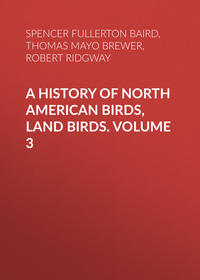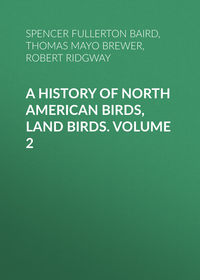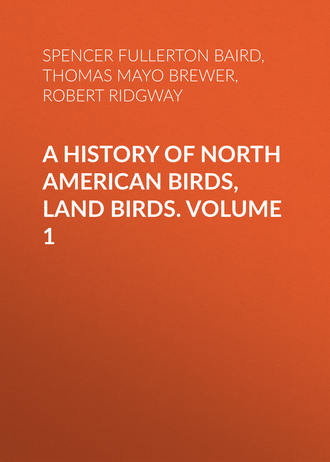 полная версия
полная версияA History of North American Birds, Land Birds. Volume 1
Another nest of this bird, obtained in Lynn by Mr. Welch, is only a reconstruction of a nest begun by a pair of Dendroica œstiva, and either abandoned by them, or from which they had been driven. Above the original nest of the Warbler the Redstarts had constructed their own. The base is composed of the downy covering of the under sides of the leaves of ferns, mixed with a few herbaceous stems and leaves. Within this was built an entirely distinct nest, composed of long and slender strips of bark, pine-needles, and stems of grasses. These are firmly and elaborately interwoven together.
A nest found in Hingham, built in a tree in an open space near a dwelling, was seven feet from the ground, and of the usual size and shape. In this the more usual strips of bark were replaced by hempen fibres of vegetables, thistle-down, bits of newspaper, and other fragments. Within is a strong lining of hair and fine stems of grasses. In this nest there were two young, about half fledged, and two eggs nearly fresh. The latter were taken, the female parent being present and making only a very slight protest, stopping, from time to time, to catch insects.
The eggs of the Redstart vary considerably in their size and in their general appearance, but resemble somewhat those of the common Summer Yellow-Bird. They vary in length from .55 to .68 of an inch, and in their breadth from .45 to .53. Their ground-color is a grayish-white, blotched and clotted with purple, lilac, and brown.
Family HIRUNDINIDÆ.—The Swallows
Char. Bill short, triangular, very broad at base (nearly as wide as long) and much depressed, narrowing rapidly to a compressed, notched tip; mouth opening nearly to the eyes. Primaries nine, graduating rapidly less from the exterior one; tail-feathers twelve. Feet weak; tarsi scutellate, shorter than middle toe and claw. Number of joints in toes normal; basal joint of middle toe partially or entirely adherent to lateral toes. Wings long, falcate. Tail forked. Eyes small. Plumage compact, usually lustrous. All the American species with a white patch on the sides under the wing, and with the irids hazel or brown.
The Hirundinidæ form a very well marked group of birds easily distinguished from all others. They exhibit a close resemblance, in external appearance and habits, to the Cypselidæ; from which, apart from the internal structure, they are readily distinguished by the possession of nine, instead of ten primaries; twelve, instead of ten tail-feathers; scutellate tarsi, toes with normal number of joints (1, 2, 3, and 4, respectively, exclusive of ungual phalanges), instead of a different proportion; differently shaped nostrils, etc. In both families the wings are developed to an extraordinary degree; the outer primary nearly twice or more than twice the length of the inner, and enabling its possessor to sustain flight almost indefinitely. The relations of the family among the Oscines appear closest to the Old World Muscicapidæ.
In comparing the wings of the Hirundinidæ with those of the Cypselidæ we readily notice one of the essential characters of the Oscines, namely, that the greater wing-coverts hide only half or less than half of the secondary quills, instead of reaching much beyond their middle, or nearly to the end. (See Sundevall, Ornith. Syst.)
The precise character of scutellation of tarsus is somewhat difficult to make out, owing to a tendency to fusion of the plates, although not essentially different from most Oscines. There is a series of scutellæ along the anterior face of the tarsus, and a longitudinal plate on each side, meeting, but not coalescing, behind. The anterior scutellæ sometimes appear to fuse into the outer lateral plate; or sometimes the latter is more or less subdivided; the inner plate is generally more distinct from the anterior scutellæ, and usually entire, except perhaps at the lower extremity.
Genera of North American Hirundinidæ.
A. Nostrils broadly oval, or circular; opening upwards and forward, and exposed; without overhanging membrane.
a. Edge of wing smooth. Tarsus short, stout; equal to middle toe without claw; feathered on the inner side above. Nostrils almost or entirely without membrane.
Bill stout; culmen and commissure much curved. Frontal feathers without bristles. Tail deeply forked. Color lustrous-black; belly and crissum sometimes white … Progne.
Bill rather weaker; commissure and culmen nearly straight to near tip. Frontal feathers bristly. Tail nearly even. Throat, rump, and crissum, and usually forehead, rufous; belly white … Petrochelidon.
b. Edge of wing smooth. Tarsus longer than in last; equal to middle toe and half the claw. Nostrils bordered along posterior half by membrane, but not overhung internally. Bill very small. Tail forked. Crissum dusky except in Neochelidon fucata. Various genera and subgenera, none North American, as Atticora, Notiochelidon, Neochelidon, and Pygochelidon.
c. Edge of wing armed with stiff recurved hooks. Tarsus as in preceding (tarsus and toes much as in Pygochelidon). Bill larger and more depressed. Tail emarginate only. Crissum white … Stelgidopteryx.
B. Nostrils lateral; bordered behind and inside, or overhung by membrane, the outer edge of which is straight, and directed either parallel with axis of bill or diverging from it.
a. Tarsus short; about equal to middle toe without claw. Tibial joint feathered; feathers extending along inside of upper end of tarsus.
Tarsus bare at lower end. Lateral claws reaching only to base of middle.
Tail very deeply forked, much longer than closed wings; lateral feathers linear and very narrow at end, twice the length of central. Upper parts and pectoral collar steel-blue; front and throat, sometimes under parts, rufous. Tail-feathers with large spots … Hirundo.
Tail with shallow fork, not exceeding half an inch, shorter than closed wings. Feathers broad. Color blue or green above, with or without white rump; white beneath. Tail-feathers without spots … Tachycineta.
Tarsus with a tuft of feathers at lower end. Lateral claws lengthened, reaching beyond base of middle claw.
Tail slightly forked. Color dull-brown above; beneath white, with brown pectoral collar … Cotyle.
b. Tarsus long; equal to middle toe and half claw; entirely bare. Tail considerably forked, about equal to closed wing. Color green above; white beneath … Callichelidon.62
Genus PROGNE, BoieProgne, Boie, Isis, 1826, 971. (Type, Hirundo purpurea vel subis, L.)—Baird, Birds N. Am. 1858, 314.
Gen. Char. Body stout. Bill robust, lengthened; lower or commissural edge of maxilla sinuated, decidedly convex for basal half, then as concave to the tip, the lower mandible falling within its chord. Nostrils superior, broadly open, and nearly circular, without any adjacent membrane, the edges rounded. Legs stout. Tarsus equal to middle toe without claw; the joint feathered; lateral toes about equal; the basal joint of the middle toe half free internally, rather less so externally. Claws strong, much curved. Nest in hollow trees. Eggs white.
The species of this genus are the most powerful and robust of the Swallows. Some are entirely glossy-black, others whitish below. The following diagnosis will show the relationship of the several forms usually recognized as distinct species:—
Species and VarietiesP. subis. Above lustrous blue-black; beneath lustrous blue-black or brownish-gray, uniform, or with the abdomen and crissum white, or whitish. Females always with the throat and jugulum gray.
A. Adult males entirely steel-blue.
a. Females and young males with the abdomen pure white.
Feathers about the anus smoky-gray beneath the surfaceWing about 6.00; fork of tail, .80 deep. ♀ and Juv. Abdominal and crissal feathers always with dusky shafts, and with the concealed portion grayish. Forehead and nape hoary grayish. Hab. Continental North America, south into Northern Mexico … var. subis.
Wing, 5.25; fork of tail considerably less. ♀ and Juv. unknown. Hab. Galapagos … var. concolor.63
Wing, 5.80; fork of tail, 1.10 deep. ♀ and Juv. unknown. Hab. Chili … var. furcata.64
Feathers about the anus snowy-white beneath the surfaceWing. 5.50; fork of tail, .90 deep. ♀ and juv. Abdominal and crissal feathers entirely snowy-white,—never with dusky shafts (except ♂ juv. in transition). Forehead dusky grayish-brown; nape steel-blue. Hab. Cuba and Florida Keys … var. cryptoleuca.
b. Females and young with the abdomen dusky grayish-brown.
Wing, 5.50; fork of tail, .80. ♀. Lower parts dusky grayish-brown, the feathers bordered with lighter grayish, producing a squamate appearance. Juv. similar, but feathers of the upper parts bordered with whitish. Hab. Paraguay (Vermejo River) … var. elegans.65
B. Adult males with the abdomen and crissum pure white.
a. Lower tail-coverts with the shafts pure white. ♂ (adult) with the throat, jugulum, and sides steel-blue.
♀ and juv. scarcely distinguishable from those of cryptoleuca. Hab. Porto Rico and Jamaica (St. Domingo also?) … var. dominicensis.66
b. Lower tail-coverts with their shafts dusky. ♂ (adult) with throat, jugulum, and sides brownish-gray.
Sides of the jugulum with a blue-black patch in the ♂. Wing, 5.50; fork of tail, .70 deep. Hab. Bolivia … var. domestica.67
Sides of the jugulum without a blue-black patch in the ♂. Wing, 5.20; fork of tail, .55 deep. Hab. Middle America, from Southern Mexico to New Granada … var. leucogaster.68
Progne subis, BairdPURPLE MARTINHirundo subis, Linn. S. N. 10th ed. 1758, 192 (Hirundo cœrulea canadensis, Edwards, Av. tab. 120, Hudson’s Bay). Progne subis, Baird, Rev. Am. Birds, 1864, 274. H. purpurea, Linn. S. N. 12th ed. 1766, 344 (H. purpurea, Catesby, Car. tab. 51).—Aud. Orn. Biog. I, pl. xxiii.—Ib. Birds Am. I, pl. xlv.—Yarrell, Br. Birds, II, 232, 274 (England and Ireland, Sept. 1842).—Jones, Nat. Bermuda, 34 (Sept. 22, 1849). Progne purpurea, Boie, Isis, 1826, 971.—Brewer, N. Am. Ool. I, 1857, 103, pl. iv, fig. 47 (eggs).—Baird, Birds N. Am. 1858, 314.—Cooper & Suckley, P. R. R. Rep. XII, 2, 186 (Fort Steilacoom).—Blakiston, Ibis, 1863, 65 (Saskatchewan)—Cooper, Orn. Cal. 1, 1870, 113.—Samuels, 260. Hirundo violacea, Gm. H. cœrulea, Vieill. H. versicolor, Vieill. H. ludoviciana, Cuv.
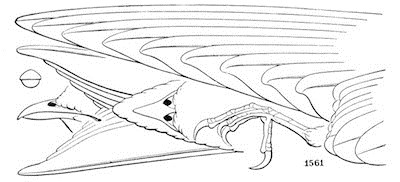
Progne subis.
1561
Sp. Char. (No. 1,561 ♂.) Entirely lustrous steel-blue, with a purplish gloss; the tail-feathers and the wings, except the lesser and middle coverts, and edge inside, dull black scarcely glossed. Tibiæ dark brownish. A concealed patch of white on the sides under the wings. Concealed central portion of anal feathers light whitish-gray.
(No. 1,129 ♀.) Above somewhat similar, but much duller. Beneath smoky brownish-gray, without lustre, paler behind, and becoming sometimes quite whitish on belly and crissum, but all the feathers always with dusky shafts, and more or less clouded with gray centrally, even though fading into whitish to the edges. This is particularly appreciable in the longer crissal feathers. The edges of the dark feathers of throat and jugulum are usually paler, imparting somewhat of a lunulated appearance, their centres sometimes considerably darker, causing an appearance of obsolete spots. There is a tendency to a grayish collar on sides of neck, and generally traceable to the nape; this, in one specimen (5,492) from California, being hoary gray, the forehead similar.
The young male of the second year is similar to the female, with the steel-blue appearing in patches.
Total length (of 1,561), 7.50; wing, 6.00; tail, 3.40; difference between inner and outer feather, .75; difference between first and ninth quills, 2.88; length of bill from forehead, .55; from nostril, .34; along gape, .94; width of gape, .74; tarsus, .61; middle toe and claw, .80; claw alone, .25; hind toe and claw, .54; claw alone, .27.
Hab. The whole of the United States and the Provinces; Saskatchewan; Cape St. Lucas and Northern Mexico (winter); Orizaba (Sumichrast); Bermuda. Accidental in England. South American and West Indian birds apparently belong to other races.
Many Western adult males are considerably less violaceous than any Eastern one; but there is so much variation in this respect among specimens from one locality, that this difference in lustre does not seem of much importance.
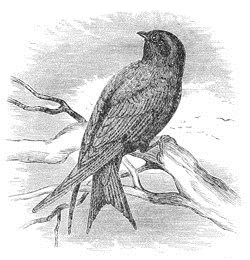
Progne subis.
An adult female (No. 61,361, G. A. Boardman) from Lake Harney, Florida, is so unlike all other specimens in the collection as to almost warrant our considering it as representing a distinct local race. It differs from females and young males of all the other races (except elegans, from which it differs in other striking particulars) in the following respects: Above, the lustrous steel-blue is uninterrupted, the forehead and nape being uniform with the other portions; beneath, dark smoky-gray, inclining to whitish on the middle of the abdomen; the jugulum and crissum have a faint gloss of steel-blue, the feathers of the latter bordered with grayish-white. The chief difference from elegans is in lacking the conspicuous grayish-white border to the feathers of the whole lower part, the surface being uniform instead of conspicuously squamated. Wing, 5.60; tail, 3.00; fork of tail, .80 deep.
Habits. The Purple Martin is emphatically a bird common to the whole of North America. It breeds from Florida to high northern latitudes, and from the Atlantic to the Pacific. It is very abundant in Florida, as it is in various other parts of the country farther north, and the large flocks of migrating birds of this species which pass through Eastern Massachusetts the last of September attest its equal abundance north of the latter State. It occurs in Bermuda, is resident in the alpine regions of Mexico, and is also found at Cape St. Lucas. Accidental specimens have been detected in England and in Ireland. It is abundant on the Saskatchewan. Burmeister states that this species is common in the vicinity of Rio de Janeiro, and that it is distributed in moderate abundance through the whole of tropical South America. Von Pelzeln also cites it as occurring on the Rio Negro and at Manaqueri through the three winter months, nesting in old buildings and in holes in the rocks. It is, however, quite possible that they refer to an allied but distinct species.
In a wild state the natural resort of this species, for nesting and shelter, was to hollow trees and crevasses in rocks. The introduction of civilized life, and with it of other safer and more convenient places, better adapted to their wants, has wrought an entire change in its habits. It is now very rarely known to resort to a hollow tree, though it will do so where better provision is not to be had. Comfortable and convenient boxes, of various devices, in our cities and large towns, attract them to build in small communities around the dwellings of man, where their social, familiar, and confiding disposition make them general favorites. There they find abundance of insect food, and repay their benefactors by the destruction of numerous injurious and noxious kinds, and there, too, they are also comparatively safe from their own enemies. These conveniences vary from the elegant martin-houses that adorn private grounds in our Eastern cities to the ruder gourds and calabashes which are said to be frequently placed near the humbler cabins of the Southern negroes. In Washington the columns of the public buildings, and the eaves and sheltered portions of the piazzas, afford a convenient protection to large numbers around the Patent Office and the Post-Office buildings.
The abundance of this species varies in different parts of the country, from causes not always apparent. In the vicinity of Boston it is quite unusual, though said to have been, forty years since, quite common. There their places are taken by the H. bicolor, who occupy almost exclusively the martin-houses, and very rarely build in hollow trees.
Sir John Richardson states that it arrives within the Arctic Circle earlier than any other of its family. It made its first appearance at Great Bear Lake as early as the 17th of May, when the ground was covered with snow, and the rivers and lakes were all icebound.
In the Southern States it is said to raise three broods in a season; in its more northern distribution it raises but one. Their early migrations expose the Martins to severe exposure and suffering from changes of weather, in which large numbers have been known to perish. An occurrence of this kind is said to have taken place in Eastern Massachusetts, where nearly all the birds of this species were destroyed, and where to this day their places have never been supplied.
Within its selected compartment the Martin prepares a loose and irregular nest. This is composed of various materials, such as fine dry leaves, straws, stems of grasses, fine twigs, bits of string, rags, etc. These are carelessly thrown together, and the whole is usually warmly lined with feathers or other soft materials. This nest is occupied year after year by the same pair, but with each new brood the nest is thoroughly repaired, and often increased in size by the accumulation of new materials.
The Martins do not winter in the United States, but enter the extreme Southern portions early in February. Audubon states that they arrive often in prodigious flocks. On the Ohio their advent is about the 15th of March, and in Missouri, Ohio, and Pennsylvania about the 10th of April. About Boston their appearance is from the 25th of April to the middle of May. Mr. Audubon states that they all return to the Southern States about the 20th of August, but this is hardly correct. Their departure varies very much with the season. In the fall of 1870 they were to be found in large flocks, slowly moving southward, but often remaining several days at a time at the same place, and then proceeding to their next halt. Their favorite places for such stops are usually a high and uninhabited hillside near the sea.
The Martin is a bold and courageous bird, prompt to meet and repel dangers, especially when threatened by winged enemies, never hesitating to attack and drive them away from its neighborhood. It is therefore a valuable protection to the barnyard. Its food is the larger kinds of insects, especially beetles, in destroying which it again does good service to the husbandman. The song of the Martin is a succession of twitters, which, without being musical, are far from being unpleasant; they begin with the earliest dawn, and during the earlier periods of incubation are almost incessantly repeated. The eggs of the Purple Martin measure .94 of an inch in length by .79 in breadth. They are of an oblong-oval shape, are pointed at one end, are of a uniform creamy-white, and are never spotted. They are quite uniform in size and shape. Eggs from Florida are proportionally smaller than those from the Northern States.
Progne subis, var. cryptoleuca, BairdCUBAN MARTINProgne cryptoleuca, Baird, Rev. Am. Birds, 1864, 277. Hirundo purpurea, D’Orb. Sagra’s Cuba, Ois. 1840, 94 (excl. syn.). Progne purpurea, Cab. Jour. 1856, 3.—Gundlach, Cab. Jour. 1861.
Sp. Char. (No. 34,242, ♂). Color much as in P. subis,—rich steel-blue, with purple or violet gloss; the wings and tail, however, much more decidedly glossed, and with a shade of greenish. The feathers around the anus and in the anterior portion of crissum with dark bluish down at base, pure snowy-white in the middle, and then blackish, passing into the usual steel-blue. The white is entirely concealed, and its amount and purity diminish as the feathers are more and more distant, until it fades into the usual gray median portion of the feather. The usual concealed white patch on the sides under the wings. Total length, 7.60; wing, 5.50; tail, 3.40; perpendicular depth of fork, .86; difference between first and ninth primary, 2.75; length of bill from forehead, .55; from nostril, .34; along gape, .86; width, .58; tarsus, .53; middle toe and claw, .79; claw alone, .24; hind toe and claw, .52; claw alone, .25.
Female (17,730, Monte Verde, Cuba, May 2; C. Wright). Above steel-blue, less glossy than in the male, and becoming lustreless dark smoky-brown on the forehead. Head, laterally and beneath, with jugulum and sides, uniform brownish-gray (without darker shafts or lighter borders to feathers, as in subis); whole abdomen, anal region, and crissum snowy-white, including the shafts. Wing, 5.40; tail, 2.80; fork of tail, .70 deep.
Young male (10,368, Cape Florida, May 18, 1858; G. Wurdemann). Similar to the female, but the steel-blue above more brilliant and continuous, the forehead and wings being nearly as lustrous as the back; throat and jugulum mixed with steel-blue feathers, and crissum with some feathers of steel-blue bordered with whitish. Wing. 5.40; tail, 2.90; fork of tail, .80 deep.
Hab. Cuba, and Florida Keys? (Perhaps Bahamas.)
This species has a close external resemblance to P. subis, for which it has usually been mistaken. It is of nearly the same size, but the feet are disproportionately smaller and weaker; while the wings are shorter, the tail is as long and more deeply forked; the feathers considerably narrower, and more attenuated (the outer .40 wide, instead of .46). The colors above are more brilliant, and extend more over the greater wing-coverts and lining of wings, while the quills and tail-feathers have a richer gloss of purplish, changing to greenish. An apparently good diagnostic feature is the concealed pure white of the feathers about the anal regions, replaced in subis by grayish, rarely approximating to whitish.
A Progne collected by Mr. Wright, at Monte Verde, is duller in color than that from Remedios, but has still more concealed white below, in the median portion, not only of the anal feathers, but of those of the entire crissum and of the belly. A female bird, which I presume to be the same species, can scarcely be distinguished from the female of dominicensis, except in the brownish shafts of the longer crissal feathers, and an almost imperceptible tinge of brownish in the webs of the same feathers. It is almost exactly like the P. leucogaster of Mexico and Central America.
This species is included in the North American fauna in consequence of the capture of a specimen (No. 10,368 ♂ juv., May 18, 1858) at Cape Florida, which is with scarcely a doubt referable to it. This specimen is a young male in its second year, so that it is difficult to ascertain positively its relationship to the two allied species; but as it agrees perfectly in its proportions with cryptoleuca, and its plumage differs from the corresponding one of subis in essential respects, we have little hesitation in referring it to the former.
Nothing distinctive is recorded as to the habits of this bird.
Genus PETROCHELIDON, CabanisPetrochelidon, Cab. Mus. Hein. 1850, 1851, 47. (Type, Hirundo melanogaster, Swains. = P. swainsoni, Scl.)
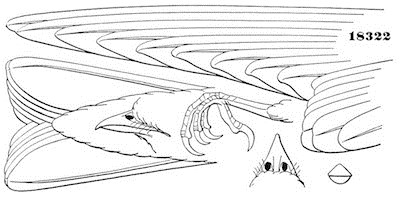
Petrochelidon lunifrons.
18322
Gen. Char. Bill stout and deep, somewhat as in Progne. Nostrils entirely superior, open, without overhanging membrane on the inner (or upper) side, but somewhat overhung by short bristles, seen also along base of inner mandible and in chin. Legs stout; the tarsi short, not exceeding the middle toe exclusive of its claw; feathered all round for basal third or fourth, though no feathers are inserted on the posterior face. Tail falling short of the closed wings, nearly square or slightly emarginate; the lateral feathers broad to near the ends, and not attenuated.




